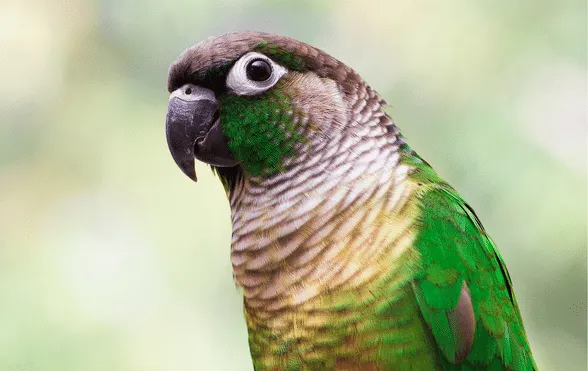Green-Cheeked Conures are friendly little birds that need attentive, loving owners. Find out what they’re like as pets.
Is your parrot insured? Get a quote for up to £5,000 of vet fee cover, death and theft cover | We’ve been insuring exotic pets since 1996 | Check out our customer reviews on Feefo.
How much does a Green-Cheeked Conure cost? | How long does a Green-Cheeked Conure live for? | Are Green-Cheeked Conures a good pet for beginners? | How long can a Green-Cheeked Conure be left alone? | Can a Green-Cheeked Conure talk? | Different colours of Green-Cheeked Conures | What do Green-Cheeked Conures eat?
Green-Cheeked Conure parakeets are an excellent option for a family pet. The birds are small, affectionate, full of personality and relatively quiet.
They demand attention but owners who put in the time playing with them can be rewarded with tricks, cuddles and even a few spoken words.
Male and female Green-Cheeked Conures look the same and tend to grow to about 10 inches. This means their cage doesn’t have to be too big and can easily fit in a flat. The birds will need a lot of toys and space to move around outside the cage.
The colourful parrots get on well with other Conures and some larger birds but you may want to avoid mixing them with smaller birds, which they may try to dominate. If you buy more than one Green Cheek be aware that they breed easily, so you may want to make sure they’re the same sex.
How much does a Green-Cheeked Conure cost?
Green-Cheeked Conures cost between £100 and £300. The price depends on the age of the bird, how it looks, and the level of training and human interaction it has had.
Young, hand-reared Conures with bright colours are likely to be more expensive although we have seen plenty of birds for sale online around the £150 to £200 price point.
Always make sure you buy a healthy bird. Consider buying from an experienced breeder or a trusted retailer recommended by owners. Feel free to ask about where the bird came from and how much handling it gets every day.
If you do buy online, you can tell the seller you’d like to see the bird in person before you make a decision.
Read our guide to the 5 things you need to know about purchasing a bird.
How long does a Green-Cheeked Conure live for?
The life expectancy of a Green-Cheeked Conure in captivity is 10 to 25 years. This is a wide age range because it depends on how well the bird is looked after and whether it has a nutritious, balanced diet.
A healthy Conure in the wild can live for over 30 years, although much more than that is rare.
There is not much data on the ages Green-Cheeked Conures live to, but it is believed cases of neglect in captivity, which include poor diet, bring down the average life expectancy.
Is your parrot insured? Get a quote for up to £5,000 of vet fee cover, death and theft cover | We’ve been insuring exotic pets since 1996 | Check out our customer reviews on Feefo.
Are Green-Cheeked Conures a good pet for beginners?
Yes, Green-Cheeked Conures can be a good option for people who have never owned a bird before.
They’re small, have an affectionate temperament, like to be taught tricks and played with, and don’t make too much noise.
The birds do require regular attention and like to be handled so they may be best suited to a beginner who is ready to commit time to owning a pet or someone who has friends or family with parrots.
Because they grow to about 10 inches their cages don’t need to be as big as other birds, such as a Cockatoo. And the birds themselves are not as expensive as some parrots. However, they are playful and need things to interact with so you’ll need to buy toys and cage accessories to stop a Green Cheek from getting bored.
If they don’t have enough to do it can affect their health or cause them to pull out their feathers.
Here are 10 ideas for homemade parrot toys.
Green-Cheeked Conures are small enough to be held by children but like any birds they can occasionally bite. They’re not known for being aggressive and biting or beak play can be trained out if an owner works on it while the bird is young.
It’s worth checking where your nearest avian vet is before you buy a bird, if it’s a long journey you may want to reconsider what kind of pet you get.
Use our site to find an exotic pet vet.
Learn more about ExoticDirect’s Parrot insurance.
How long can a Green-Cheeked Conure be left alone?
You’re probably fine to leave a Green-Cheeked Conure on its own during the day if you work away from home but you need to commit time to be with it every day.
And the length of time you can leave it will depend on how much time you spent with it while it was younger. For example, if you buy a bird at a time you’re working from home, spend hours with it but after a year you get a job in an office, the bird may become stressed when you suddenly disappear for most of the day.
If you’re going away on holiday your bird will need someone to feed it, clean it and give it some attention. It will survive without you but it will definitely be pleased to see you when you get home.
Although Green-Cheeked Conures need plenty of attention and human interaction, some of that can just be sitting with you while you’re working or watching TV. They’re happy to hang out with humans or cuddle up on the sofa. And they’ll let you know if they want to play.
Check out our Parrot care guide.
Can a Green-Cheeked Conure talk?
Yes, Green-Cheeked Conures can be taught to say a few words. They’re not the best birds for talking because their voice is slightly gravelly but they can mimic some human speech.
In general, they’re a quiet bird but they do love human interaction so if you put in the time they can learn to talk, although not every bird is guaranteed to pick it up.
Green-Cheeked Conures are like parrotlets in that they’re both small, quiet birds that can learn to speak a bit.
Find out how and why Parrots talk.
Different colours of Green-Cheeked Conures
Conures have a range of colours and markings that are known as mutations. Here are some of the most popular:
- Turquoise
- Pineapple
- Yellow-sided
- Cinnamon
If you’re buying a particular colour, make sure you’ve seen pictures of that colouring before you pay for the bird. Some mutations may look similar so it’s important you’re not being miss-sold a more common Conure.
Yellow-sided Conures are rarer in the wild but shouldn’t be too difficult to find in captivity.
What do Green-Cheeked Conures eat?
Green-Cheeked Conures eat a range of fruits, vegetables and seeds.
These are some of their favourite foods:
- Banana
- Raisins
- Sunflower seeds
- Hemp seeds
- Potatoes
- Carrots
- Corn
- Pasta
Some people suggest pellets with a calcium supplement should make up 60% to 70% of a Conure’s diet, the rest can be fruit and vegetables, and the occasional treat.
Is your parrot insured? Get a quote for up to £5,000 of vet fee cover, death and theft cover | We’ve been insuring exotic pets since 1996 | Check out our customer reviews on Feefo.
Own a cat or dog? Get pet insurance that covers up to £12,000 for dogs and £9,000 for cats in vet fees every year, including dental for illness and accidents with British Pet Insurance.

